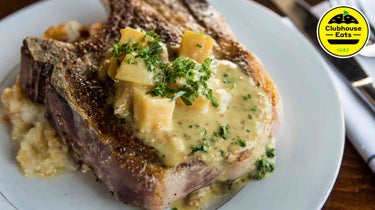6 keys to making great chili, according to a Texas golf-club chef

No matter how you prepare your chili, here's how to do it right.
Getty Images
Welcome to Clubhouse Eats, where we celebrate the game’s most delectable food and drink. Hope you brought your appetite.
***
Chili is a shape-shifter of a dish, morphing from one region to the next and from one kitchen to another. Some traditionalists argue that it isn’t chili if it’s made with beans. Others insist that almost anything goes: beans, boar, turkey, tofu, butternut squash.
Bill Osloond is not a chili absolutist.
Born in South Dakota, he cut his culinary chops in Colorado, Missouri and Indiana before settling in Texas, where he serves as culinary director of Horseshoe Bay Resort, about an hour northwest of Austin.
Texans are serious about their chili, and many have strict definitions for it. Osloond’s views are more easygoing.
But there are some chili rules by which he does abide. Here are six.
6 keys to making great chili
1. Beans or no beans — it’s up to you
“I am from the Midwest and can go either way.” Mostly, he says, it depends on the context. “If I’m making chili as a soup, I would add beans. For a topping on a hot dog, I would not.” As for the type of beans, “always pinto,” Osloond says, preferably from made from scratch. “But I wouldn’t shame you if you use canned beans.”
2. Time and temperature
What’s good for your backswing works well with chili, too. That means cooking low and slow. How slow depends on the ingredients you’re using. Ground beef and pork, for instance, cook relatively quickly. Any longer than 30 to 45 minutes, Osloond says, and they risk turning “mealy and try.” Short ribs, chuck and brisket are a different story. They call for braising. At minimum, Osloond says, chili should cook for an hour, but that won’t give you the deepest flavors. A slow-cooked chili can go much longer, with a maximum, Osloond says, of “four to six hours.”
3. “Secret” ingredients
As some chili aficionados tell it, any chili worth its salt should have a “secret” ingredient, just a little something-something to kick things up a notch. Maybe a shot of bourbon. Or peanut butter in the base. Osloond doesn’t have a “secret,” and if he did, he wouldn’t tell it or it would spoil the secret. But, he says, “I do like Worcestershire sauce and mustard.” In moderation. “Not enough that you can taste. More of a background flavor,” he says.
4. Spice levels
Heat should be present but not “overpowering,” Osloond says. How to achieve that is another matter. While a lot of it comes down to personal taste, it also depends on the type of spice you’re using. Dry spices go in early. Fresh spices go in late.
5. Toppings
On a well-made chili, Osloond says you can “take them or leave them.” If you choose to use them, it’s hard to beat the standards: grated cheddar, onions, scallions and sour cream.
6. On the side
In the Midwest, where he was raised, Osloond developed a taste for a regional favorite: chili, with cinnamon rolls on the side. “My wife doesn’t agree,” he says. If you can’t get behind that pairing, either, go with a classic. “Cornbread is a winner,” Osloond says.











